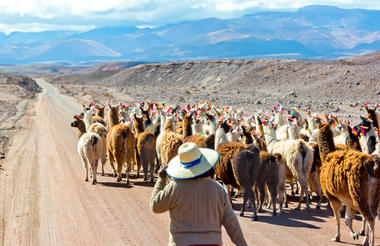An enticing mix of historical architecture, picturesque views and sprawling vineyards await travellers to Salta, located in the lovely Lerma Valley in the Andean foothills. Simply wandering through the streets of the central city area will take you past a variety of impressive 18th and 19th-century buildings, including the neoclassical Cathedral of Salta, the ornate Church of Saint Francis and the Museum of High Mountain Archaeology – housing a collection of ancient Inca relics. Other popular attractions are the area’s array of exceptional wineries, and the panoramic views over the region visitors from the top of San Bernado Hill.



The ochre cliffs of the Cerro de los Siete Colores (The Hill of Seven Colours) form a magical backdrop to this charming rural village. The colourful layers have been formed over 600 million years by the accumulated deposits of sea, lake and river sediments. The unmistakeable image of the village against these multi-hued mountains can be found on postcards across the country. Every day there is a vibrant market in the central square, where locals and tourists can purchase clay pots, woven goods and handicrafts. Don’t miss a visit to the village church, Iglesia de Santa Rosa de Lima, which was declared a national monument in 1941.



The small town of San Pedro de Atacama is a scenic oasis in the Atacama Desert, surrounded by the imposing volcanic peaks of the Chilean altiplano and located close to several major archaeological and natural attractions. The fascinating ancient sites of Tulor and Quitor, the enthralling Atacama Salt Flat, the jaw-dropping turquoise Altiplanic Lagoons, and the other-worldly Tatio Geysers all lie nearby, and as a result, the village has become a significant tourist destination. Despite its small size it encompasses a wide range of restaurants; however, it is also known for its ‘western feel’ and retains an old-world charm. History enthusiasts will enjoy a visit to the atmospheric 17th-century Iglesia San Pedro. However, it is really the breathtaking surroundings that make this destination special.



The Siloli Desert is the world’s highest desert, resting at an altitude of 4550 metres above sea level. It is located close to Bolivia’s border with Chile and considered to be an extension of the neighbouring Atacama Desert. Visitors to this remote part of the world can look forward to dramatic views of geometrically cracked salt pans and rust-coloured hills. The desert’s most iconic feature is the Árbol de Piedra, a seven-metre high sandstone formation that resembles a gnarled tree and was shaped by the region’s harsh winds over thousands of years. The tiny settlement of Ojo de Perdiz has a spattering of guesthouses and a fascinating community, while the nearby Pastos Grandes Lagoon is a shallow salt lake set below a volcanic mountain where you can see flocks of flamingos and revel in the breathtaking scenery.



Situated in the Bolivian province of Daniel Campos, the town of Tahua and the surrounding eponymous municipality is home to some of the most spectacular landscapes in South America. The area is dotted with tiny Bolivian villages, blanketed with an endless white salt plain and covered with mountains rising from a lunar-like landscape. Resting at the foot of the sacred Tunupa Volcano, the little village of Tahua sits on the edge of the world’s largest high altitude salt flat, the Salar de Uyuni, which is undoubtedly the main highlight in the province. This vast salt desert is one of the most awe-inspiring spectacles in the country. Visitors will find a variety of wildlife living in and around this area including flamingos, rheas, vicunas, and foxes. Don’t miss the fascinating Fish Island, featuring a rocky island outcrop comprised entirely of fossilized coral and scattered with giant prehistoric cacti.



Potosi, located in Bolivia's southern highlands, became famous after 1545 when silver was discovered by the Spanish in the Cerro de Potosi mountain. The city was the site of the Spanish colonial mint and the largest and wealthiest in the region. As well as being a functioning mine, today the Cerro Rico is also home to several impressive industrial monuments such as artificial lakes, aqueducts, and the 'barrios mitayos' that the miners called home. Visitors can tour the cooperative mine and then explore the town’s grand churches, mansions and monasteries - atmospheric and beautiful evidence of long gone wealth and the reason for Potosi’s is World Heritage site status.



Sucre holds the honour of being Bolivia’s capital and is also considered the nation’s most beautiful city. Set in a valley in the south-central region of the country, Sucre enjoys an eternal spring – perfect weather for walking its narrow streets and discovering a city that remains almost exactly as it was a century ago. The UNESCO World Heritage site is home to some of the best examples of Spanish colonial architecture in South America, and the white-washed facades of the buildings have earned Sucre the title of “The White City”.



Surrounded by the peaks of the Andean Plateau and overlooked by the 6402m Mt. Illimani, La Paz is a truly breathtaking city whose buildings sprawl across the surrounding canyon, reaching altitudes of up to 4100m. While the sight of the city is reason enough to visit, La Paz holds a number of attractions sure to keep tourists fascinated. Take a walk along Calle Jaen, a colonial street lined with museums, explore the city's cathedrals or wander through some of the colourful markets, including the 'Witches' Market' where llama foetuses and dried frogs can be found for sale.







